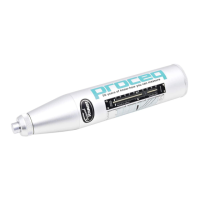6 Measurement © 2017 Proceq SA
• Determine which conversion curve is appropriate for
the selected body shape (see Fig. 2.5 to Fig. 2.10,
page 7 to page 9). Then, using the average rebound
value R
m
and the selected conversion curve, read off
the average compressive strength.
Note the impact direction!
The average compressive strength is subject
to a dispersion (±4.5 N/mm
2
to ±8 N/mm
2
).
2.3.3 Median Value
In chapter 7 of the Standard EN 12504-2:2001 "Test
Results", the median value is specified instead of the
classic mean value.
When applying this method, all measured values must
be considered (no outliers allowed).
The median value must be determined as follows:
• The measured values are placed in a row according to
the size.
• For an odd number of impacts, the value placed in
the middle of the row, is to be taken as the median
value.
• For an even number of impacts, the mean value of the
two values, placed in the middle of the row, is the
median value.
• If more than 20% of the values are spaced more than
6 units apart, the measuring series must be rejected
as mentioned in the standard.
2.4 Conversion Curves
2.4.1 Derivation of the Conversion Curves
The conversion curves (Fig. 2.5 to Fig. 2.10) for the con-
crete test hammer are based on measurements taken
on many sample cubes. The rebound values R of the
sample cubes were measured using the concrete test
hammer. Then the compressive strength was ascertained
on a pressure testing machine. In each test, at least 10
test hammer impacts were performed on one side of the
test cube which was lightly clamped in the press.
2.4.2 Validity of the Conversion Curves
- Standard concrete made from Portland or blast furnace
slag cement with sand gravel ( maximum particle size
dia. ≤ 32 mm )
- Smooth, dry surface
- Age: 14 - 56 days
Empirical values:
The conversion curve is practically independent of the:
- cement content of the concrete,
- particle gradation,
- diameter of the largest particle in the fine gravel
mixture, providing the diameter of the maximum
particle is ≤ 32 mm,
- water / cement ratio

